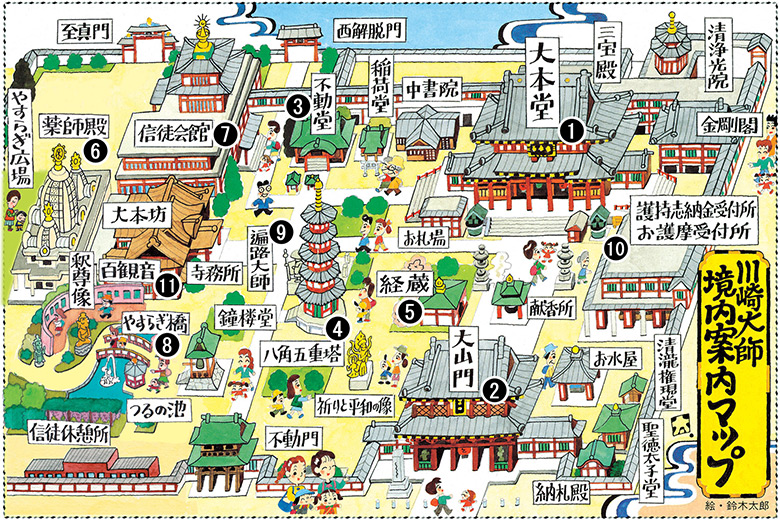
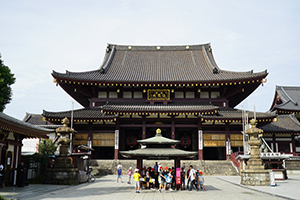
The image of Kobo Daishi (Kukai 774-835), the founder of the Shingon Buddhism, believed to ward off all evil, is enshrined in the middle of the hall. It is the center of the doctrine and the focus of the prayers of Kawasaki Daishi. In the main hall, Ogoma Kito, the rite of burning, is conducted every day, seeking world peace and safety for adherents.
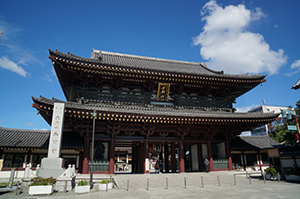
The main gate of the temple. Statues of the Four Heavenly Kings, guardians of the four compass directions, rest on the gate.

The statue of Fudo-Myoo (Acala) is enshrined.
Fudo-Myoo is regarded as an incarnation of Dainichi Nyorai (Mahavairocana), a fundamental Buddha of Shingon Esoteric Buddhism. Fudo-Myoo bears a sword in his right hand, a lariat in his left hand and a flame on his back. Fudo-Myoo protects people by burning away all worldly desires, defilements and impediments, and leads them towards enlightenment.

This pagoda is derived from stupas in India in which Buddha's ashes are kept. The five-layer structure represents the five basic elements of the universe of Buddhism: earth, water, fire, wind and sky respectively. The pagoda symbolizes Dainichi Nyorai (Mahavairocana), an important Buddha in Shingon Esoteric Buddhism.
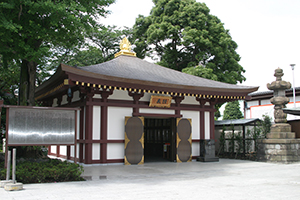
The principle image displays a statue of Shaka Nyorai (India), the 7,240 books of Kenryuban Daizokyo in a wall shelf (China), two dragons painted on the center of the ceiling (Korea), and a Buddhist painting spread in four directions on the ceiling (Japan), and tells the story of how Buddhism came from India through China and the Korean Peninsula. The five-pronged pestle in front of the Shaka Nyorai statue symbolizes the highest position of Shingon Esoteric Buddhism, and contributing gold leaf is believed to be able to connect one with Buddha.
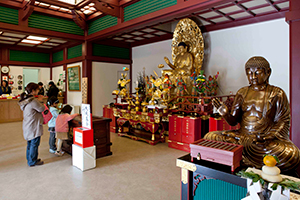
The statue of Yakushi Nyorai is herein enshrined. Yakushi Nyorai has the mudra position of the right hand, to brush away evil and fear, and a medicine pot in the left hand to heal supplicants and offer protection by the twelve divine generals. You can pray for recovery from illness and for a sound body by gently stroking the part of the statue that relates to your own ailment.
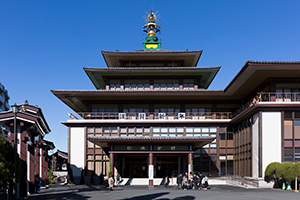
The hall was built to provide a place for followers to rest and socialize. It offers special films featuring the temple and its events, which are shown on a large TV monitor located on the first floor. This hall is also the venue for traditional Buddhist wedding ceremonies.

The vermilion-colored bridge is believed to ward off evil and bring good fortune. Sanskrit characters are engraved on the handrails of the bridge.
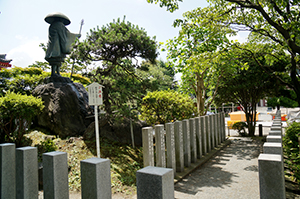
The statue of Kobo-Daishi (Kukai 774-835) signifies the pilgrimage he made around Shikoku Island. Sand from each temple of the 88 sacred places on Shikoku Island have been positioned under the stone pillars around the statue. Visitors can pray for health and stamina when on lengthy treks by sprinkling water on the straw sandals in front of the statue.
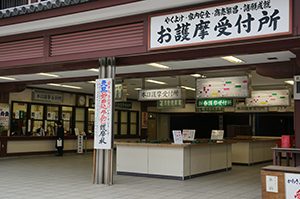
This is a registration office for Ogoma, the rite of burning, where supplicants can create prayers for various kinds of wishes, including world peace and the safe keeping of followers, in the main hall.
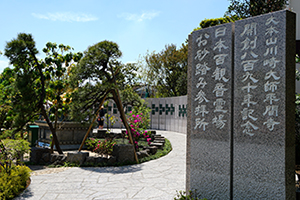
Nihon Hyaku Kannon Reijo Osunafumi Sanpaijo
(Sand Stepping Worship Field of Hundred Kannon Temple of Japan)
Samples of sand from each of 100 Kannon temples in Japan have been placed in the field. Reliefs of Kanzeon Bosatsu (the Buddhist Goddess of Mercy) from 100 temples, and a bronze statue of Sho-Kannon are enshrined here.
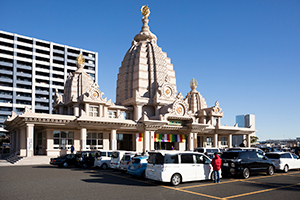
The outward appearance of Indian temple-style architecture is rare in Japan. The principle image here is Kobo Daishi (Kukai 774-835). The hall was established to pray for the safety of automobiles, drivers and passengers.
1-1-1 Daishigawara,Kawasakiku,Kawasaki,Kanagawa 210-0811,Japan